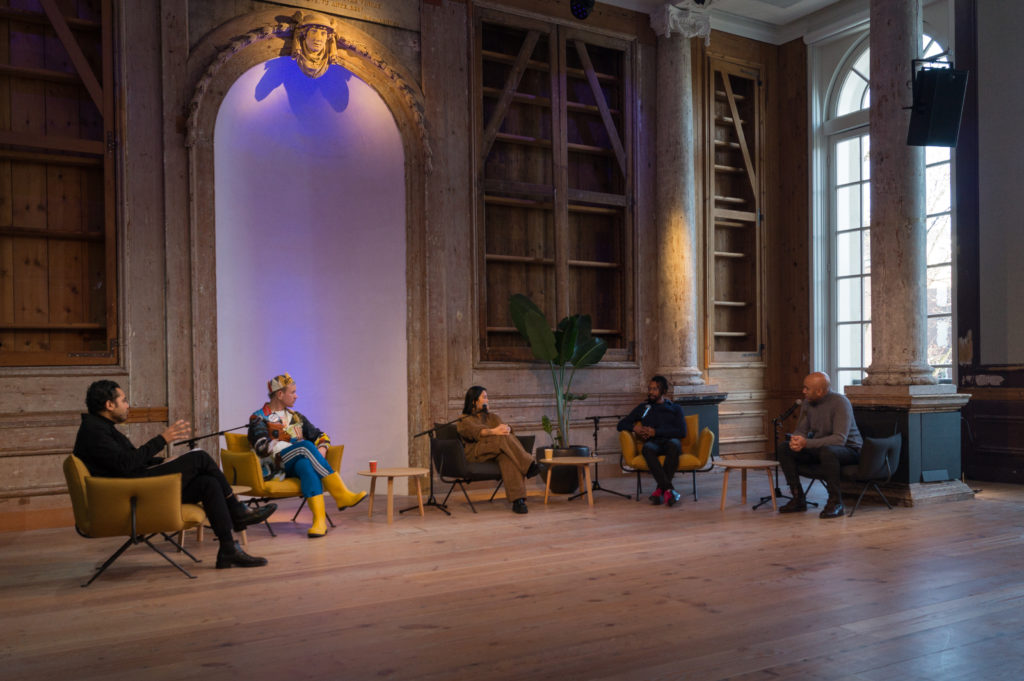essay
Fluid diversity in the city’s cultural ecosystem
door Rowan Stol
28 June 2021essay
Bas Kosters
On 12 February 2021, Amsterdam Museum live-streamed a symposium from Felix Meritis. The symposium was inspired by the exhibition Refresh Amsterdam and investigated the state of the city’s artistic climate through panel discussions, a column and a performance. The second panel discussion focused on the various descriptive and defining labels applied to and by makers, with Bas Kosters (artists, fashion designer), Sioejeng Tsao (illustrator, activist), Christian Guerematchi (dancer, choreographer) and Clayde Menso (director of Amerpodia). Amsterdam Museum asked Rowan Stol to write an essay based on the discussion.
Artist. Activist. Artivist. The speakers nod as the various labels they apply to themselves are discussed. It may seem contradictory to explore how makers describe themselves in a panel dedicated to the critical discussion of such descriptions – yet it is an unavoidable part of today’s artistic climate to be subjected to categorization.
The search for appropriate labels must be conducted with care, since the conventional labels are inextricably connected to certain views and associations, as is the case with the ambiguous term “urban arts”. Taken at face value, the term should be widely applicable, covering a variety of art produced in or on the subject of cities. Yet in practice, it appears that the term is primarily used to describe art created by Black makers. The result is that many makers are pigeonholed into the same “urban” category, however varied their work may be. For example, in an interview with Tyler the Creator, the musician described his winning of the Grammy for Best Rap Album in 2018 as an ambivalent compliment. Although the award represented a recognition of his work, but only within the confines of a clearly demarcated category. The “Rap” category acts as a catch-all for many different genres, each of which has its own influences and forms of expression. Despite the great deal of development and innovation taking place in the world of rap, and despite the fact that other forms of music are allowed the privilege of diversity, rap music is still reduced to a single category. And even then it’s often not seen as real art.
Christian Guerematchi is critical of the way the term “urban arts” is used by institutes for similar reasons. He sees the same division in the world of dance, where “urban” dance is distinguished from, say, classically trained dance. Only the latter is considered art, and is therefore appreciated as high culture. Guerematchi argues that newer forms of dance should be embraced, and that we should let go of the distinction between “high” and “low” culture. This is a distinction that is maintained through the associations inherent in categorizing labels like “urban arts”. To differentiate between different forms of arts, considering some as more legitimate than others, is to do a disservice to the quality and fluidity of contemporary makers.
The concept of what a “maker” should be similarly restricts the reality of artistic practice. There are still funds who require applicants to have graduated from an art school. Sioejeng Tsao, a self-taught illustrator, is living proof of why such requirements are unfair to artists: they imply that artisthood must be legitimized by an institute in order to have validity. Tsao adds that not all people have families who encourage artistic careers, due to the lack of financial certainty. By setting such requirements, funds exclude makers who have nevertheless chosen to walk this path under their own steam.
At the same time, labels can be useful for makers to profile themselves within a particular niche, and thereby to reach relevant groups, Tsao says. Clayde Menso adds that funds with such labels as “urban” explicitly aim to reach makers who have so far been under-represented in funds. These makers must be actively sought out to ensure that the money finds its way to them, too. However, none of this changes the fact that the devolution of “urban” into a catch-all label that no one recognizes themselves in any longer is an unwelcome and harmful development.
To get a grip on the constantly expanding world of art, we are always looking for ways to classify people, practices and art forms. Yet by and large, these labels remain too restrictive for contemporary makers. The panel calls for a more fluid approach in which the contemporary artistic climate is treated as a perpetually shifting ecosystem, rather than a structured grid of predefined categories and pigeonholes. An ecosystem that also comprises independent initiatives by makers as well as night culture, Menso emphasizes. We must recognize the fluid diversity of makers and their practices before we can start becoming a sector that revolves around the freedom to create.


